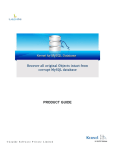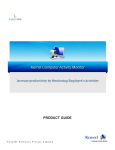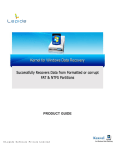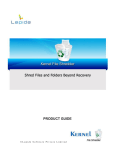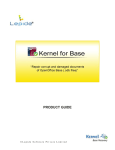Download User`s Guide - Kernel Data Recovery
Transcript
PRODUCT GUIDE ©L e pide Sof t w a r e P r iva t e L im it e d Table of Contents 1. 2. 3. 4. 5. 6. 7. About Kernel for VHD ........................................................................................................................................4 1.1 About the Manual ........................................................................................................................................4 1.2 Introduction to Kernel for VHD ....................................................................................................................4 1.3 Salient Features ...........................................................................................................................................4 1.4 System Requirements ...................................................................................................................................5 Getting started with the User Interface ..................................................................................................................6 2.1 Welcome Screen ..........................................................................................................................................6 2.2 Menu Bar ....................................................................................................................................................6 2.3 Tool Bar......................................................................................................................................................9 2.4 Buttons Used ...............................................................................................................................................9 Install and Uninstall........................................................................................................................................... 11 3.1 Install Kernel for VHD............................................................................................................................... 11 3.2 Uninstall Kernel for VHD .......................................................................................................................... 11 Using Kernel for VHD....................................................................................................................................... 13 4.1 Recover Data Using Quick Scan Mode........................................................................................................ 13 4.2 Recover Data Using Extensive Scan Mode .................................................................................................. 17 4.3 Recover Data Using File Trace Mode .......................................................................................................... 22 Download Purchase and Register........................................................................................................................ 29 5.1 Free Trial Download .................................................................................................................................. 29 5.2 Purchase & Register................................................................................................................................... 29 5.3 Support ..................................................................................................................................................... 29 Troubleshooting ................................................................................................................................................ 31 6.1 Common Issues ......................................................................................................................................... 31 6.2 Frequently Asked Questions ....................................................................................................................... 31 Legal Notices .................................................................................................................................................... 32 7.1 Copyright Notice ....................................................................................................................................... 32 7.2 Trademarks ............................................................................................................................................... 32 7.3 Disclaimer ................................................................................................................................................. 32 7.4 License Agreement .................................................................................................................................... 32 ©L e pide Sof t w a r e P r iva t e L im it e d Table of Figures Figure 2.1: Welcome Screen........................................................................................................................................6 Figure 2.2: Recovery Menu .........................................................................................................................................7 Figure 2.3: View Menu ...............................................................................................................................................7 Figure 2.4: Tools Menu ...............................................................................................................................................8 Figure 2.5: Help Menu ................................................................................................................................................9 Figure 4.1: Selecting VHD File for Quick Scan Recovery Mode .................................................................................. 13 Figure 4.2: Selecting Drive to Recover for Quick Scan Recovery Mode ....................................................................... 14 Figure 4.3: Selecting the Partition for Quick Scan Recovery Mode .............................................................................. 15 Figure 4.4: Selecting Folder to Recover for Quick Scan Recovery Mode ...................................................................... 16 Figure 4.5: Displaying successful saving of files for Quick Scan Recovery Mode ......................................................... 17 Figure 4.6: Selecting Recovery Mode for Extensive Scan Mode .................................................................................. 18 Figure 4.7: Selecting partitions for Extensive Scan Mode ............................................................................................ 19 Figure 4.8: Customizing the settings for Extensive Scan Mode .................................................................................... 20 Figure 4.9: Selecting Folder to recover for Extensive Scan Mode................................................................................. 21 Figure 4.10: Displaying successful saving of files in Extensive Scan Mode .................................................................. 22 Figure 4.11: Selecting Recovery Mode for File Trace Method ..................................................................................... 23 Figure 4.12: Selecting Drive to Recover for File Trace Method.................................................................................... 24 Figure 4.13: Selecting Partition to Recover for File Trace Method ............................................................................... 25 Figure 4.14: Selecting File Types to Recover for File Trace Method ............................................................................ 26 Figure 4.15: Selecting path to save the recovered data in File Trace Method ................................................................. 27 Figure 4.16: Displaying successful saving of recovered data in File Trace Method ........................................................ 28 ©L e pide Sof t w a r e P r iva t e L im it e d 1. About Kernel for VHD 1.1 About the Manual Welcome to the user manual of Kernel for VHD which is an output-driven tool that repairs corrupted or damaged Virtual Hard Disk files and recovers data from them. This user manual helps in guiding the users about using the tool efficiently. It is recommended that novice as well as experienced users should carefully go through this user manual before using the software. A user who is well aware of the software can even use table of contents for finding the particular portion of manual. The table of contents enlists all the sections described in this manual from where one can navigate through different sections of this user manual. The user manual consists of step-by-step guidelines for using Kernel for VHD. The user manual consists of the following sections: About Kernel for VHD Getting started with the User Interface Install and Uninstall Using Kernel for VHD Download Purchase and Register Troubleshooting Legal Notices 1.2 Introduction to Kernel for VHD Kernel for VHD is an advanced, effective, and powerful tool that repairs corrupted, damaged or inaccessible VHD files accurately and flawlessly. The utility supports VHD files created using Windows 8, Windows 7, Windows Server 2008 R2 and Hyper-V Server. The software comprises of three powerful recovery modes for recovering data that got lost due to various reasons. The software preserves the data integrity, formatting and properties while recovering. VHD files may get corrupted due to various reasons such as virus attacks, RAID failure, accidental damage due to fire or water, hard disk crash, damaged storage media, unintentional deletion of data stored in hard disk, and so on. Kernel for VHD uses powerful algorithms for restoring the lost or deleted data and is fast, simple and easy-to-use software. 1.3 Salient Features Key features of Kernel for VHD are: ©L e pide Sof t w a r e P r iva t e L im it e d Recovers data from lost, deleted, inaccessible, corrupted or damaged VHD files. Recovers all types of data such as image files, video files, audio files, database files, documents, media files, archives, etc. Resolves all types of corruption issues in VHD files. Provides three powerful recovery modes-Quick Scan, Extensive Scan, and File Trace for recovering data. Provides options to quickly search partitions of VHD file. Users can show or hide the progress of data retrieving process. Supports recovery of data from VHD files created using Windows Server 2008, Windows Server 2008 R2, Hyper-V Server, Windows Vista, Windows 7, and Windows 8. 1.4 System Requirements The computer system must have the appropriate configuration before installing and running Kernel for VHD. Following are the minimum system requirements that a system should possess for successfully installing the Kernel for VHD software. Basic System Requirements Pentium Class Processor 64 MB RAM (128 MB recommended) 10 MB of free disk space for software installation Supported Windows OS Platforms Windows 8 Windows 7 Windows Vista Windows XP Windows 2000 Windows 2003 Windows Server 2008/R2 ©L e pide Sof t w a r e P r iva t e L im it e d 2. Getting started with the User Interface 2.1 Welcome Screen Now, you have got clear idea about the features of Kernel for VHD, so it’s the time to get acquainted with the working of the tool. When you install and run Kernel for VHD, following welcome screen appears: Figure 2.1: Welcome Screen 2.2 Menu Bar The Menu bar of Kernel for VHD comprises following four menus: Recovery Menu View Menu ©L e pide Sof t w a r e P r iva t e L im it e d Tools Menu Help Menu Recovery Menu Recovery menu of the Kernel for VHD software appears, as shown in the following figure: Figure 2.2: Recovery Menu Following table enlists the options available in the Recovery menu: Option Description Open Select this option to add corrupt VHD file to the application. Recover Selected Select this option to start the process of saving the recoverable data. Save Recovery Snapshot Select this option to save the recoverable data as snapshot when you do not have time to sit and wait for the data to be saved on your computer’s hard disk or another storage media. Load Recovery Snapshot Select this option to load the saved snapshot. Exit Select this option to close the software. View Menu The View menu allows changing the pattern of viewing the recovered files in the software. View menu of Kernel for VHD software appears, as shown in the following figure: Figure 2.3: View Menu ©L e pide Sof t w a r e P r iva t e L im it e d Following table enlists the options available in the View Menu: Option Description Icons Select this option to view the recovered files in form of icons. List Select this option to view the recovered files in a list-like structure. Details Select this option to view the recovered files with complete details such as size, type, date, etc. Tools Menu Tools menu of Kernel for VHD software appears, as shown in following figure: Figure 2.4: Tools Menu Following table enlists the options available in the Tools menu: Option Find Files File Filters Settings Description Select this option to find specific file(s) from the recovered file(s). For example, if you need to view .xls files, then type *.xls in “Find Files” dialog box and the software will display all the MS Excel file(s) amongst the recovered files. This option works similar to the Find Files option. However, the only difference among both is using the Find Files option, you can search for a specific type of file, say *.xls but with the File Filters option, you can specify multiple file types, say *.xls, *.docx, *.pdf, etc. Based on the file type(s) you specify, the software displays the recovered items. Select this option to configure following software settings based on which the software will search the lost files and folders: Sectors to be read in one attempt. Rename, overwrite, or skip the duplicate files. Include deleted files in the search, exclude deleted files from recovered files, or only recover the deleted files. Drive Information Select this option to gather information about the system drive. Help Menu ©L e pide Sof t w a r e P r iva t e L im it e d Help menu of the Kernel for VHD software appears, as shown in following figure: Figure 2.5: Help Menu Following table enlists the options available in the Help menu: Option Description Help Select this option to view Help manual of the software. About Kernel for VHD Select this option to view version information and software support details of the software. 2.3 Tool Bar Tool bar consists of buttons that work as shortcuts for various options available in the main menus of Kernel for VHD software. Following table enlists the buttons available on the Tool bar of the software: Button Button Name Description Recover Click this button to start the saving process. Save Snapshot Click this button to save the recovery snapshot. Load Snapshot Click this button to load the recovery snapshot. Find Click this button to enter and search specific file types amongst thousands of file(s) recovered by the software. Click this button to view and modify following software settings based on which the software will search the lost files and folders: Setting Sectors to be read in one attempt Rename, overwrite, or skip the duplicate files Include deleted files in the search, exclude deleted files from recovered files, or only recover the deleted files Number of retries on bad sectors Buy Online Click this button to purchase the software online. Help Click this button to view Help manual of the software. 2.4 Buttons Used ©L e pide Sof t w a r e P r iva t e L im it e d There are several buttons used in the software that helps user throughout the recovery process. Following table lists the buttons used in the software: Button Description Click this button to start the saving process. Click this button to hide the searching process. While searching for the files and folders on the selected hard disk partition or logical disk drive, the software displays the progress. If you do not want to see that progress then just click the “Hide Progress” button. Clicking the “Hide Progress” button also improves the recovery speed. Click this button to view the searching progress. Click this button to proceed to next step during the recovery process. Click this button to navigate back during the recovery process. Click this button to stop the searching or saving process inbetween. ©L e pide Sof t w a r e P r iva t e L im it e d 3. Install and Uninstall 3.1 Install Kernel for VHD The software can be installed by following few simple steps. However, before doing so, you need to ensure that the software installer file is available with you. If it is not available, it can be downloaded from the site http://www.nucleustechnologies.com/vhd-recovery.html After downloading the installer file, execute the following steps for installing the software: 1. Double- click Kernel for VHD installer file. 2. Follow the on-screen instructions. When the installation process completes ‘Setup Installation Complete’ message appears on the software installation screen. 3. Click the Finish button to launch the software. After the completion of software installation process, a shortcut to start the software will be added in the Windows Start Program menu. User can start the software from Program menu. One can also create desktop icon of the software where from it can be started by double clicking the icon. 3.2 Uninstall Kernel for VHD User can uninstall Kernel for VHD software from computer system by using one of the following two methods: Uninstall from Windows Start menu Uninstall from Control Panel Note: Before starting the un-installation process, make sure that the Kernel for VHD software is not in use. Uninstall from Windows Start menu Execute the following steps to uninstall Kernel for VHD from Windows Start menu: 1. Click Start > All Programs > Kernel for VHD > Uninstall Kernel for VHD. A warning message before uninstalling the software will be displayed on the screen. 2. Click Yes button to uninstall the software. 3. Click the OK button. Kernel for VHD is successfully uninstalled from computer system. ©L e pide Sof t w a r e P r iva t e L im it e d Uninstall from Control Panel Execute the following steps to uninstall Kernel for VHD from Control Panel: 1. Click Start > Control Panel. The Control Panel window appears. 2. Double-click the Add or Remove Programs icon. A list of the programs installed on the computer system appears. 3. Select Kernel for VHD and click the Remove button. A warning message before uninstalling the software will be displayed on the screen. 4. Click the Yes button to uninstall the software. 5. Click the OK button. Kernel for VHD is successfully uninstalled from the computer system. ©L e pide Sof t w a r e P r iva t e L im it e d 4. Using Kernel for VHD Kernel for VHD provides three extensive file recovery modes which recover corrupted, inaccessible or damaged VHD files. The recovery modes are as follows: Quick Scan Extensive Scan File Trace 4.1 Recover Data Using Quick Scan Mode The Quick Scan mode is the fastest recovery mode and resolves minor corruption issues in VHD files stored in the hard disk of the computer. Execute the following basic steps to recover data using Quick Scan mode. 1. Click Start > All Programs > Kernel for VHD > Kernel for VHD to launch the software. The welcome screen of the software appears. 2. Browse and select the VHD file. Figure 4.1: Selecting VHD File for Quick Scan Recovery Mode 3. Select Quick Scan mode. The Quick Scan interface appears. 4. Select Virtual Hard Disk from the left panel of the window. The detail of the virtual hard disk is shown in the right panel. 5. Click Next to continue the recovery process. ©L e pide Sof t w a r e P r iva t e L im it e d Figure 4.2: Selecting Drive to Recover for Quick Scan Recovery Mode A dialog box is displayed. Select the radio button Use existing partition info to recover data from an existing partition on the selected hard disk. Else, select Search partition option. 6. Click OK to continue. The partition searching process takes place. You can stop the process in between by using the Stop button. The available partitions are displayed in the left panel. ©L e pide Sof t w a r e P r iva t e L im it e d Figure 4.3: Selecting the Partition for Quick Scan Recovery Mode 7. Select any partition displayed in the left panel of the window. You can view the details of the partition by clicking it. 8. Click Next. The folder searching process is executed. Note: You can show or hide the progress of the search process by clicking the Hide Progress/ Show Progress buttons. When the search process completes, all the folders are enlisted in the left panel. You can expand the folders and view their details displayed in the right panel. 9. Select and check the folders which you want to recover. 10. Click Recover button. The software displays a dialog box asking you to provide the location for saving the recovered files. ©L e pide Sof t w a r e P r iva t e L im it e d Figure 4.4: Selecting Folder to Recover for Quick Scan Recovery Mode 11. Specify the location to save the selected items and click OK button. When the saving process is done, the software displays a dialog box containing message regarding successful saving of files. ©L e pide Sof t w a r e P r iva t e L im it e d Figure 4.5: Displaying successful saving of files for Quick Scan Recovery Mode 12. Click OK button to close the dialog box. You can view the recovered files from the specified locations. 4.2 Recover Data Using Extensive Scan Mode The Extensive Scan Mode is the powerful recovery mode that performs intensive scanning of the corrupted or damaged VHD files. This mode can effectively recover the files that cannot be recovered by Quick Scan mode. Execute the following steps to recover data using Extensive Scan mode: 1. Click Start > All Programs > Kernel for VHD > Kernel for VHD to launch the software. The welcome screen of the software appears. 2. Browse and select the VHD file. ©L e pide Sof t w a r e P r iva t e L im it e d Figure 4.6: Selecting Recovery Mode for Extensive Scan Mode 3. Select Extensive Scan mode. The Extensive Scan interface appears. 4. Select Virtual Hard Disk from the left panel of the window. The detail of the virtual hard disk is shown in the right panel. 5. Click Next to continue the recovery process. A dialog box is displayed. Select the radio button Use existing partition info to recover data from an existing partition on the selected hard disk. Else, select Search partition option. 6. Click OK to continue. ©L e pide Sof t w a r e P r iva t e L im it e d Figure 4.7: Selecting partitions for Extensive Scan Mode The partition searching process takes place. User can stop the process in between by using the Stop button. The available partitions are displayed in the left panel. 7. Click Next. 8. Select the File System from the left panel of the window. 9. Click Next. ©L e pide Sof t w a r e P r iva t e L im it e d Figure 4.8: Customizing the settings for Extensive Scan Mode The folder searching process is executed. Note: You can show or hide the progress of the search process by clicking the Hide Progress/ Show Progress buttons. You can also stop the search process by clicking the Stop button. When the search process completes, the recovered file system is enlisted in the left panel. Select the file Click Next. All the folders within this file are listed in the left panel. You can expand the folders and view their details displayed in the right panel. 10. Select and check the folders which you want to recover. 11. Click Recover button. The software displays a dialog box asking you to provide the location for saving the recovered files. ©L e pide Sof t w a r e P r iva t e L im it e d Figure 4.9: Selecting Folder to recover for Extensive Scan Mode 12. Specify the location to save the selected items and click OK button. When the saving process is done, the software displays a dialog box containing message regarding successful saving of files. 13. Click OK button to close the dialog box. ©L e pide Sof t w a r e P r iva t e L im it e d Figure 4.10: Displaying successful saving of files in Extensive Scan Mode User can view the recovered files from the specified locations. 4.3 Recover Data Using File Trace Mode The File Trace method is capable to recover those files that cannot be recovered with Quick Scan and Extensive Scan modes. With the help of raw scanning of the corrupted and damaged files, it recovers the data. Using following simple steps, recover the VHD files using File Trace method: 1. Click Start > All Programs > Kernel for VHD > Kernel for VHD to launch the software. The welcome screen of the software appears. 2. Browse and select the VHD file. ©L e pide Sof t w a r e P r iva t e L im it e d Figure 4.11: Selecting Recovery Mode for File Trace Method 3. Select File Trace mode. The File Trace interface appears. 4. Select Virtual Hard Disk from the left panel of the window. The detail of the virtual hard disk is shown in the right panel. 5. Click Next to continue the recovery process. ©L e pide Sof t w a r e P r iva t e L im it e d Figure 4.12: Selecting Drive to Recover for File Trace Method A dialog box is displayed. Select the radio button Use existing partition info to recover data from an existing partition on the selected hard disk. Else, select Search partition option. 6. Click OK to continue. The partition searching process takes place. You can stop the process in between by using the Stop button. The available partitions are displayed in the left panel. 7. Click Next. ©L e pide Sof t w a r e P r iva t e L im it e d Figure 4.13: Selecting Partition to Recover for File Trace Method 8. Click OK to continue. The File Types interface appears. Note: You can select single or multiple file types for recovery. 9. Check the files you want to recover from the File Types interface. 10. Click OK to continue. Data searching process takes place. ©L e pide Sof t w a r e P r iva t e L im it e d Figure 4.14: Selecting File Types to Recover for File Trace Method Note: You can show or hide the progress of the search process by clicking the Hide Progress/ Show Progress buttons. You can also stop the search process by clicking the Stop button. After successful completion of search process, the folders with all file types inside them are displayed in a treelike structure in the left panel. You can expand the folders and view their details displayed in the right panel. 11. Select the file types that you want to recover. 12. Click Recover button. The software displays a dialog box asking you to provide the location for saving the recovered files. 13. Specify the location to save the selected items and click OK button. ©L e pide Sof t w a r e P r iva t e L im it e d Figure 4.15: Selecting path to save the recovered data in File Trace Method When the saving process is done, the software displays a dialog box containing message regarding successful saving of files. 14. Click OK button to close the dialog box. ©L e pide Sof t w a r e P r iva t e L im it e d Figure 4.16: Displaying successful saving of recovered data in File Trace Method User can view the recovered files from the specified locations. ©L e pide Sof t w a r e P r iva t e L im it e d 5. Download Purchase and Register 5.1 Free Trial Download Kernel for VHD is available as trial version for FREE to download so that a user can analyze the features, functionalities, capabilities and can understand the complete working of the software. The trial version works almost same as that of the full version but with a limitation that it does not allow saving the recovered VHD files. To avoid this limitation, purchase the full version of the software. Free version of Kernel for VHD can be downloaded from our website: http://www.nucleustechnologies.com/download-vhd-recovery.html 5.2 Purchase & Register Purchase the Full version of Kernel for VHD software for saving the recovered files and folders. The FREE trial version of the software allows you to preview the recovered items but does not allow saving them. For saving the recovered items, purchase the complete version of the software. You can purchase the software through our website: http://www.nucleustechnologies.com/buy-vhd-recovery.html (encrypted and secure site). Payment and Delivery Purchase the Kernel for VHD software from our authorized resellers, which provide number of payment options for your ease - Paypal, FAX, Credit Card, E-cheque, Pay Order, etc. After making the purchase transaction with our resellers, an email is sent consisting of activation details and download link of the Full version comprising of the activation code. This email is sent to the email address, which you have used while processing the purchase transaction with our resellers. We suggest you not to use false e-mail address while making the purchase transaction. For any other details related to at: [email protected] purchase process, software activation process, email us 5.3 Support Lepide Software Pvt. Ltd. provides round-the-clock technical support for its product range to solve technical and software queries. The software comes with an embedded help manual that can be accessed by clicking Help in the software main window. You can also press the F1 key on the keyboard of your computer to access the embedded help manual of Kernel for VHD. Telephone Support: +91-9818725861 ©L e pide Sof t w a r e P r iva t e L im it e d 1-866-348-7872 (Toll Free for USA/CANADA) Email Support: [email protected] for Sales [email protected] for Support [email protected] for General Queries ©L e pide Sof t w a r e P r iva t e L im it e d 6. Troubleshooting 6.1 Common Issues What are the limitations in trial version of Kernel for VHD? The free demo version of Kernel for VHD works almost same as that of the full version of the software but with a limitation that it does not allow saving the recovered VHD files. 6.2 Frequently Asked Questions 1. How to purchase Kernel for VHD? One can buy Kernel for VHD from our website: http://www.nucleustechnologies.com/buy-vhd-recovery.html 2. I have lost my full version for Kernel for VHD. Can you help me? Please email us at [email protected]. Please include your name, address, email address, and order confirmation number (if you have it). We will be happy to help you. 3. What are the three recovery modes in Kernel for VHD? The three recovery modes for Kernel for VHD are Quick Scan, Extensive Scan, and File Trace. 4. What are the supported Windows OS Platforms for Kernel for VHD? The supported Windows OS Platforms for Kernel for VHD are: Windows 8, Windows 7, Windows Vista, Windows XP, Windows 2000, Windows 2003, and Windows Server 2008/R2. 5. What are the various reasons for corruption of VHD files? VHD files may get corrupted due to partition deletion, partition damage and partition formatting. 6. Give the link for downloading the free trial version of Kernel for VHD. The free trial version of Kernel for VHD can be downloaded using the link: http://www.nucleustechnologies.com/download-vhd-recovery.html ©L e pide Sof t w a r e P r iva t e L im it e d 7. Legal Notices This section comprises the legal specification about Kernel for VHD and the company LEPIDE SOFTWARE Private Limited. 7.1 Copyright Notice Lepide Software Private Limited, Kernel for VHD, accompanied user manual, and documentation are copyright of Lepide Software, with all rights reserved. Under the copyright laws, this user manual cannot be reproduced in any form without the prior written permission of Lepide Software. No Patent Liability is assumed, however, with respect to the use of the information contained herein. © LEPIDE SOFTWARE PVT LTD. All rights reserved. 7.2 Trademarks Kernel for VHD® is a copyright work of Lepide Software Private Limited. Windows 95®, Windows 98®, Windows ME®, Windows NT®, Windows 2000 Server®, Windows 2000 Advanced Server®, Windows 2003 Server®, MS Word® and Windows XP® are registered trademarks of Microsoft Corporation. All other brand and product names are trademarks or registered trademarks of their respective companies. 7.3 Disclaimer The information contained in this manual, including but not limited to any product specifications, is subject to change without notice. Lepide Software Private Limited provides no warranty with regard to this manual or any other information contained herein and hereby expressly disclaims any implied warranties of merchantability or fitness for any particular purpose with regard to any of the foregoing. Lepide Software Private Limited assumes no liability for any damages incurred directly or indirectly from any technical or typographical errors or omissions contained herein or for discrepancies between the product and the manual. In no event shall Lepide Software Private Limited be liable for any incidental, consequential special or exemplary damages, whether based on tort, contract or otherwise, arising out of or in connection with this manual or any other information contained herein or the use there of. 7.4 License Agreement Kernel for VHD © by Lepide Software Private Limited. Your Agreement to this License ©L e pide Sof t w a r e P r iva t e L im it e d You should carefully read the following terms and conditions before using, installing, or distributing this software, unless you have a different license agreement signed by Lepide Software Pvt Ltd. The terms and conditions of this License describe the permitted use and users of each Licensed Copy of Kernel for VHD. For purposes of this License, if you have a valid license, you have the right to use a single Licensed Copy of Lepide. Scope of License Each Licensed Copy of Kernel for VHD may either be used by a single person or used non-simultaneously by multiple people who use the software personally installed on a single workstation. All rights of any kind in the Lepide, which are not expressly granted in this License, are entirely and exclusively reserved to and by Lepide Software. You may not rent, lease, modify, translate, reverse engineer, decompile, disassemble, or create derivative works based on, Lepide, nor permit anyone else to do so. You may not make access to Lepide available to others in connection with a service bureau, application service provider, or similar business, nor permit anyone else to do so. Warranty Disclaimers and Liability Limitations Kernel for VHD, and any and all accompanying software, files, data and materials, are distributed and provided as is and with no warranties of any kind, whether expressed or implied. In particular, there is no warranty for the quality of data recovered. You acknowledge that good data processing procedure dictates that any program, including Kernel for VHD, must be thoroughly tested with non-critical data before there is any reliance on it, and you hereby assume the entire risk of all use of the copies of Kernel for VHD covered by this License. This disclaimer of warranty constitutes an essential part of this License. In addition, in no event does Lepide Software authorize you or anyone else to use Kernel for VHD in applications or systems where Kernel for VHD Failure to perform can reasonably be expected to result in a significant physical injury, or in loss of life. Any such use is entirely at your own risk, and you agree to hold Lepide Software harmless from any and all claims or losses relating to such unauthorized use. General This License is the complete statement of the agreement between the parties on the subject matter, and merges and supersedes all other or prior understandings, purchase orders, agreements, and arrangements. This License shall be governed by the laws of the State of Delhi. Exclusive jurisdiction and venue for all matters relating to this License shall be in courts and for a located in the State of Delhi, and you consent to such jurisdiction and venue. There are no third party beneficiaries of any promises, obligations, or representations made by Lepide Software herein. Any waiver by Lepide Software of any violation of this License by you shall not constitute, nor contribute to, a waiver by Lepide Software of any other or future violation of the same provision, or any other provision, of this License. ©L e pide Sof t w a r e P r iva t e L im it e d




































